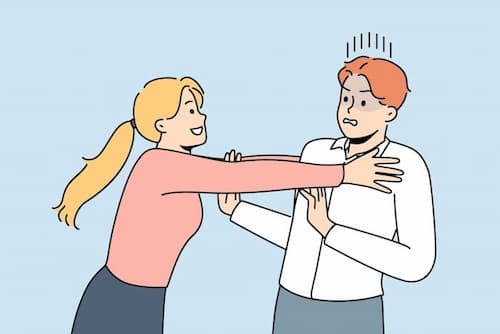“Attachment” is a term meant to describe the way that we connect with each other in the context of emotional safety and trust. When Attachment Theory was developed (Bowlby and Ainsworth), the concept was given that early in life, the way a child’s needs are met (or not) impacts the way that they will experience relational security throughout their lives.
If we think about it, attachment isn’t just an abstract emotional theory – it’s a survival need. Evolutionarily speaking, a helpless infant’s chances of survival go way up if it is securely attached to a primary caregiver. Likewise, an adult’s chances of survival go way up if they are able to attach and integrate securely into the tribe. We are hardwired to connect with others and to create interpersonal safety. .
Secure attachment looks like feeling acknowledged, understood and valued in a relationship. There is an ability to communicate with safety and the people involved help each other’s (and their own) emotional needs to be met.
Not all attachment looks emotionally secure, however. Based on considerations like what you experienced in childhood, relational trauma, grief and loss, or other factors, you may attach in a way that feels anxious, avoidant or ambivalent. These styles of attachment can affect the quality of your relationships and leave you and your partner feeling anything from obsessive to resistant to confused to stuck.
Throughout our lives we interact with people and create attachments in our relationships. Sometimes we have different styles of attaching with different kinds of people. Each relationship domain may have different attachment energy based on how you show up with that person. For example, you may have anxious attachment to your employer because, even though you have a comfortable relationship, there is a hunger to please them, a persistent worry that they may not approve of you, and pre-existing financial fears. You may have a bit of avoidant attachment with a family member that is hyper critical of your life choices. And in the middle of all of this, you may have secure attachment with your primary partner.
When we understand the nuances of the four primary attachment styles, we can really get to the heart of our patterns and our relational behavior. We can begin to make sense of why we do the things we do, and where those relational traits come from.
As we navigate through our day to day life, we form relationships at virtually every step of the way. Some of those interactions end up being close relationships that drive us to form deeper, more meaningful emotional connections.
Some of these connections develop a closeness that makes us feel acknowledged, understood, and loved for who we are. In other words, we form a close attachment. It is a fundamental aspect of human behavior that shapes the way we form connections and interact with others.
However, not all styles of attaching are the same, although they do share a common denominator. Each significantly influences how we perceive ourselves and others, impacting our emotional well-being and the quality of our current and future relationships.
For this reason, it is essential to familiarize ourselves with different attachment styles, including the secure attachment, the avoidant attachment, the ambivalent attachment, as well as the anxious attachment. All of these attachment styles provide us with a framework to better comprehend the complex nature of human behavior, especially in the romantic relationship domain.
What Do The 4 Attachment Styles Mean?
In the 1950s, psychologist John Bowlby developed the Attachment Theory, a prominent framework for understanding human behavior and the dynamics of interpersonal relationships through four adult attachment styles. His work revolutionized our understanding of how early childhood experiences with primary caregivers shape our attachment styles in relationships and subsequent behaviors in adulthood.
Four main adult relationships attachment styles in psychology, that are at the core of this framework are:
- Secure attachment style;
- Anxious attachment style (Preoccupied; in children: anxious-ambivalent);
- Avoidant attachment style (Dismissive; in children: anxious-avoidant);
- Disorganized attachment style (in children: Fearful-Avoidant).
Out of the four, the latter three are known as “insecure attachment styles”, due to the way they manifest.
By exploring these four styles, we can gain valuable insights into the patterns and dynamics that influence our interactions with others. Additionally, we can learn to nurture attachments that lead to enhanced emotional well-being and fulfilling connections.
At PIVOT, we look at these attachment styles through the lens of energy which we will speak to at the end of this article. The reason for this is that individuals rarely connect using one style in everyday life.
Secure Attachment Style: The Foundation Of Trust And Security
This attachment style forms the bedrock of healthy relationships. Securely attached adults feel comfortable with physical and emotional intimacy, as well as independence, displaying a sense of trust, security, and emotional availability. They have confidence in their worthiness of love and exhibit effective communication skills and empathy.
Strengths:
- Strong sense of self-worth and confidence;
- Capable of forming healthy, fulfilling intimate relationships;
- Effective communication skills;
- Comfortable with both intimacy and autonomy.
Challenges:
- May struggle to empathize with individuals with insecure attachment styles;
- May have difficulty understanding the experiences of those with insecure attachment styles.
In intimate relationships, these individuals can provide support and comfort to their romantic partners, while also maintaining their own autonomy. They understand the importance of open communication, express their needs clearly, and readily seek and offer support when needed. Strong sense of self-worth and believing in the reliability of others, allows securely attached individuals to foster romantic relationships based on trust, mutual respect, and emotional connection through secure attachment behaviors.
Anxious (Preoccupied) Attachment Style: The Quest For Reassurance
Individuals with an anxious attachment style crave deep emotional connection and reassurance from their partners. However, they often experience heightened anxiety and fear regarding abandonment or rejection, which can lead them to display clingy behavior, as well as struggle with boundaries. If they possess this as one of the main attachment styles, individuals who fall into the anxious attachment style category often exhibit the following traits:
Strengths:
- Deep capacity for emotional connection and empathy;
- Strong desire for closeness and intimacy;
- Attuned to the emotional needs of others.
Challenges:
- Heightened anxiety and fear of rejection or abandonment;
- Tendency to seek constant reassurance and validation;
- Potential for emotional reactivity and clingy behavior.

In romantic relationships, these individuals tend to be more emotionally reactive (as opposed to proactive) and may be hypersensitive to perceived signs of rejection or neglect. They desire constant closeness and reassurance, frequently seeking validation from their partners to alleviate their anxieties.
Avoidant (Dismissive) Attachment Style: Independence Over Intimacy
Individuals fostering avoidant attachment value independence and self-reliance above deep emotional connection. Individuals with avoidant attachment styles often prioritize maintaining their own autonomy, which can drive them to downplay the importance of close relationships. Furthermore, they may struggle with vulnerability and emotional expression, which can manifest as a tendency to avoid intimacy.
Strengths:
- Emphasizes independence and self-reliance;
- Comfortable with personal space and autonomy;
- May excel in maintaining individuality within adult romantic relationships.
Challenges:
- Difficulty expressing emotions and vulnerabilities;
- May struggle with forming deep emotional connections;
- Tendency to avoid intimacy and emotional closeness.
In romantic relationships, avoidants may often seek to maintain control over their emotions, preferring self-sufficiency over-relying on others for support. This can make it difficult for them to empathize with their partner’s needs and feelings, which is why they often appear emotionally distant or detached.
Disorganized (Fearful-Avoidant) Attachment Style (at PIVOT, we call this Ambivalent): Torn Between Closeness And Independence
Individuals with this attachment style often struggle with ambivalent feelings, simultaneously desiring intimacy while fearing rejection and abandonment. At PIVOT, we call this Ambivalent. They may display erratic behaviors, fluctuating between moments of seeking connection and moments of pushing others away.
Strengths:
- Deep capacity for emotional depth and intensity;
- Strong desire for both closeness and independence;
- Reflective and introspective nature.
Challenges:
- Internal conflict and fear of rejection and engulfment, often accompanied by negative self image;
- Difficulty establishing and maintaining stable relationships;
- Struggle with vulnerability and may exhibit erratic behaviors.
In romantic relationships, those with a fearful-avoidant attachment style may experience a constant inner tug-of-war, vacillating between moments of seeking closeness and then retreating due to fear of emotional pain. These individuals may exhibit a fear of rejection or engulfment, leading to difficulties in establishing and maintaining stable, trusting adult relationships.
Is There A Best Attachment Style?
Due to it fostering trust, emotional availability, and effective communication (among other strengths), the secure attachment style is generally considered the most adaptive and desirable. However, it’s important to note that this doesn’t mean other styles are inherently bad or that individuals fostering them are doomed to fail in their close relationships.
As we’ve seen, attachment styles vary in their characteristics and tendencies, with each having its own strengths and challenges. Additionally, these behaviors develop based on early experiences and the environment in which individuals grew up.
What we can extrapolate from this is that attachment styles are still learned behaviors. Deeply ingrained ones, yes, but still learned, which means a person can learn to manage and, in some cases, instigate a complete attachment style change, swapping an insecure for a healthier, more secure attachment type.
In a lot of cases, doing so will require a lot of practice, most likely aided by a professional (personal coach or therapist). It is a daunting prospect but the rewards are more than worth the effort, as a person can cultivate more secure attachment patterns leading to them developing healthier, more fulfilling, and secure relationships.
We like to think of attachment as energy so clients can understand how they are attaching in “real time” meaning in the moment. Someone might attach securely to their best friend whom they trust and anxiously to a co-worker whom they don’t trust. Pivoting from one style to another can happen with healthy boundaries and self-esteem.
What Is The Unhealthiest Attachment Style?
The fourth attachment style (fearful-avoidant which we call Ambivalent) is commonly regarded as the unhealthiest, mainly due to its conflicting nature. As we said, individuals with this style are often in a state of internal struggle and emotional turmoil.
On the one hand, they experience a deep longing for emotional connection. On the other, there’s the fear of rejection or engulfment. This state of being “trapped between heaven and hell” can drive a person to oscillate between moments of seeking closeness and then withdrawing to protect themselves from potential emotional pain.
Needless to say, this inconsistency can make it incredibly complex and challenging for the ambivalent to establish and maintain stable, trusting relationships. However, it is once again important to recognize that this is a learned behavior.
Ambivalent attachment style often stems from earlier life experiences, such as inconsistent caregiving or traumatic events that have caused deep-seated fear and mistrust, both of which can be addressed with professional help, and quite successfully.
Can I Have All 4 Attachment Styles?
Yes. It is important to note that attachment styles are not fixed or static. They can change over time and be influenced by various factors such as personal growth, life experiences, and therapeutic interventions. And, as mentioned above, you can have varying styles based on the nature of the relationship or situation.
What this implies is that individuals can transition from one dominant attachment style to another as they gain self-awareness and work towards developing more secure attachment styles, as a part of the human development process.

Improve Your Relationships By Making Your Attachment Style More Secure With PIVOT
You no longer have to struggle with insecurities in your relationships just because your attachment style dictates so. All you have to do is seek support from experienced professionals. With PIVOT’s help, you can turn it all around and you can do so in the complete safety of our serene Glass House retreat. Here, our expert personal coaches stand ready to guide you through the process of self-discovery, using tailored techniques and proven therapeutic approaches.
We’ll help you navigate the complexities of your attachment style and equip you with effective coping strategies, empowering you to cultivate more secure and satisfying relationships. Get in touch with us today and embrace the support and guidance that will lead you to a more fulfilled life.

